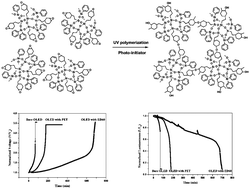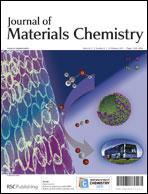High performance organic-inorganic hybrid barrier coating for encapsulation of OLEDs†
Abstract
UV curable cycloaliphatic epoxy functionalized oligosiloxane resin is synthesized by non-hydrolytic sol–gel reaction for application in encapsulation of organic light emitting devices (OLEDs). The physical and chemical properties of polymerized cycloaliphatic epoxy hybrid materials (hybrimers) are easily tunable by controlling the precursors. A single hybrimer coating on a PET film is optically transparent and shows low permeability of up to 0.68 g m−2 day−1 per mil measured by a Ca degradation test. It is found that the permeability is influenced by the


 Please wait while we load your content...
Please wait while we load your content...